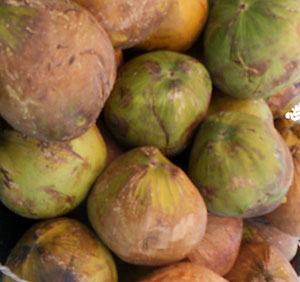¡Ay, que calor! What heat! My comadre makes her way through the market at a slower pace than usual, stopping wherever there is room in the crowd to fan herself. Forgetting that temperatures are still a good ten degrees cooler than in most of the country, she and others here in Mexico’s high central plateau seem to wilt during the temporada de calor, the hot season. While certainly nothing like the heat of the low coastal regions, it is a big change, with spring being the hottest, driest season in much of Mexico, after winter and before the start of the rainy season.

This is when the ice cream vendors and the women selling fresh fruit drinks do their biggest business, and when I look for anyone selling coco de agua, the young coconuts that vendors equip with a straw for sipping the clear liquid inside, considered one of the world’s best rehydration fluids. With impressive quantities of potassium and electrolytes, this fluid is particularly appreciated in the hot coastal regions. We may not be in the tropics, but several kinds of tropical fruit, including coconut, are enormously popular in other parts of Mexico.
Coconut is widely used in drinks, desserts, sweets, and even savory dishes, but perhaps its most interesting aspect is the history, or rather, mystery, of its arrival in Mexico, a subject of speculation and debate among botanists, historians and culinary anthropologists. Some suggest that it originated in the area around the Indian Ocean and others that it came here from the northwestern region of South America.
The light, fibrous husk of Cocos nucifera, a member of the palm family, allowed it to be carried on ocean currents to new homes far and wide. It is plentiful in nearly all tropical areas of the world, including the US states of Hawaii and Florida. Its name comes from the Spanish word coco, meaning monkey, because the early Spanish explorers found the fruit’s three indentations, or “eyes,” to resemble a monkey’s face. The “nut” part is a misnomer, since coconuts are botanically classified not as nuts, but as drupes, the coconut “meat” being the fleshy part of the inner seed.
Once mature, coconut palms bloom up to thirteen times a year, providing a year-round supply of fruit. In many tropical areas, the coconut provides not only its nutritious liquid, but also “meat” that can be eaten fresh or dried, oil for cooking and soap making, and fiber to make fishnets, mats, brushes and rope. The plant’s fronds are used to weave the thatched structures called palapas, common sights on Mexico’s beaches.
Coconuts are also used to make an alcoholic beverage called tuba. According to Guadalupe Silva, writing in Mexico Desconocido, the tradition of making a fermented coconut drink originated in the Philippines and came to Mexico with workers who arrived in the 16th century on the Manila galleons, the Spanish ships that sailed between Mexico’s west coast and the Philippines. Tuba is still a popular regional drink along that coast, especially in Colima.
Fresh, young coconuts are usually sold for their water, and these are the ones hawked in the market with straws poking out of them. (Some vendors pour the liquid into a plastic bag that gets tied around a straw.) More mature coconuts have thicker and more flavorful flesh, though not as much water. Mature coconuts should still have some water, though not as sweet as the liquid in young coconuts, and make a sloshing sound when shaken.
When buying coconuts, listen for the sound of some liquid, since a completely dry coconut may be moldy or rotten. Avoid coconuts with surface cracks and those with liquid coming from the “eyes,” since both these characteristics indicate fruit that is past its prime. It is best to use a fresh coconut as soon as possible after purchasing, although it can be kept in the refrigerator for a couple of days. The meat can be stored in the freezer from 1 to 3 months, and dried coconut has a shelf life of 6 to 12 months.
To crack open a coconut, use a hammer and nails, or a drill, to poke holes through the eyes, turn it over and pour out whatever liquid is inside. Then wrap the coconut in a towel and place it on a hard surface, such as concrete, and hammer until it cracks open. You can hit the large pieces a few more times to break them into more manageable sizes. Use a knife to scrape away the pieces of brown shell that remain on the outside. Eat the flesh as is, or use it in recipes.
Canned unsweetened coconut milk is not milk at all, but a liquid produced by grating fresh coconut and soaking it in water. Canned unsweetened coconut milk was once difficult to find in Mexico, and a trip to an Asian grocery store in one of the large cities was the only way to buy it. Nowadays, it is sold in most large grocery stores, as well as Costco and Sam’s Club. Sweetened coconut “cream,” such as Coco Lopez, has always been fairly easy to find and is used in several tropical cocktails. The nutritious water from young coconuts is also sold in cans, in places where this drink is not available fresh, under the brand names Zico and Vita Coco, among others.
So treat yourself to an ice cold coconut drink, alcoholic or not, close your eyes and let the taste of the tropics delight your taste buds, cool you off, and inspire you to prepare a few of the following recipes featuring coconut, including two for coconut shrimp, one fried and one baked.
- Baked coconut shrimp with mango sauce: Camarones con coco y mango al horno
- Coconut cream tart: Tartaleta de coco
- Camarones al coco Coconut shrimp: Camarones al coco
- Coconut sweets: Cocadas
- Coconut flan: Flan de coco
- Coconut and lemongrass rice: Arroz con coco y te limón
